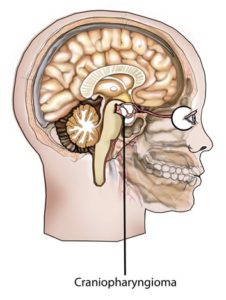Clinical Topic
Publication Date
February 16, 2021
What is Craniopharyngioma?
Craniopharyngioma is a brain tumor in the midline of the brain. This is located near the hypothalamus and pituitary gland, and where the two optic nerves cross each other (chiasm). The hypothalamus and pituitary gland play an important role in making and adjusting the levels of the body’s hormones. The optic nerves are important for vision/ eyesight. Because of this location, craniopharyngiomas can affect any or all of these structures. These tumors usually have both cystic (areas filled with fluid) and solid (areas filled with tissue) parts, and may also have areas containing calcium. The most common age-groups to develop a craniopharyngioma are between 5-14 years and 50-74 years of age. Craniopharyngioma is a rare tumor, affecting 0.5-2 out of every 1 million people each year, with up to half of these being children or adolescents.

What causes Craniopharyngioma?
Craniopharyngiomas arise from remains of cells along the path which the developing pituitary gland travels. Craniopharyngiomas are not caused by any event during pregnancy, and there are no known ways to prevent it from happening.
A craniopharyngioma is not considered to be ‘cancer,’ as it does not spread to other parts of the body. However, it does tend to grow and destroy normal structures around it. It may also grow back after surgery.
What are the signs and symptoms of Craniopharyngioma?
Because of its location, a craniopharyngioma can cause headache or nausea from increased pressure inside the brain. It can also compress the optic nerves causing blurred vision or loss of peripheral vision. It is urgent to seek medical help when a child has vision- related complaints. Damage caused to the optic nerves by craniopharyngioma can result in permanent blindness.
Pituitary gland function may be affected by craniopharyngiomas and can lead to the following hormone issues:
- Growth hormone deficiency -> short height, poor growth. This is the most common hormonal complication of craniopharyngiomas.
- Disorders of puberty hormone production -> Precocious puberty (breast buds before 8 years of age in girls, and increase in the size of the testicles before 9 years of age in boys) or delayed puberty (absence of puberty signs after 13 years in girls and 14 years of age in boys), arrested or slowed puberty, or absence of menstrual periods (menstruation) in pubertal girls.
- Stress hormone/ cortisol deficiency -> fatigue, low blood pressure, low blood sugar, dizziness, abdominal pain, difficulty recovering from stress or illness.
- Thyroid hormone deficiency -> low energy, constipation, cold intolerance, changes in hair or skin, menstrual disturbances.
- Inability to hold onto water -> excessive urination and dehydration. This is a condition called diabetes insipidus and often develops after surgery for craniopharyngioma.
The hypothalamus is also affected by craniopharyngiomas and can cause the following issues:
- Changes in appetite
- Obesity
- Changes in behavior
- Disruption in usual sleep/wake cycles
- Fluctuations in body temperature
- Fluctuations in heart rate and blood pressure
- Difficulty feeling thirsty (loss of thirst sensation)
How is Craniopharyngioma diagnosed?
Craniopharyngioma is diagnosed based on the signs and symptoms mentioned above. If these issues are present, your doctor may order imaging of the brain. CT scans and MRIs of the brain can detect craniopharyngiomas. An MRI takes excellent pictures of the brain while avoiding radiation. A CT scan detects calcifications, which occur in 90% of craniopharyngiomas. Blood tests of pituitary hormone levels help evaluate for hormone issues. Visual field testing by an ophthalmologist (eye specialist) can help to see if the optic nerves are affected.
How is Craniopharyngioma treated?
Treatment for craniopharyngioma depends on the location and size of the tumor. In some cases, the entire tumor can be removed with surgery. In other cases, partial removal of the tumor is performed, followed by radiation treatment. There are many new surgical and radiation techniques available as treatment options.
The endocrine complications may occur at any time before or after treatment and are treated as follows:
| Endocrine Issue | Treatment |
| Growth hormone deficiency | Growth hormone replacement |
| Deficiency of puberty hormones | Replacement of sex hormones |
| Precocious Puberty | GnRH agonists (medication to halt puberty) |
| Adrenal insufficiency | Replacement of cortisol (stress hormone) |
| Thyroid hormone deficiency | Replacement of thyroid hormone |
| Diabetes Insipidus | Replacement of anti-diuretic hormone |
| Obesity | Diet, exercise, weight loss medications, or surgeries |
Treatment decisions are made on an individual basis with your medical team. It is important to have close follow up with your team of doctors. This may include an endocrinologist, neurosurgeon, ophthalmologist, oncologist, and/or radiologist. You should contact your doctor if your child continues to have symptoms or with any further questions.
References:
Muller, HL. Craniopharyngioma. Endocrine Reviews. 2014;35(3):513-543.
